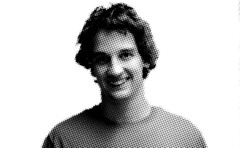 Two police cruisers pause side by side on a one-way street, waiting to pull into the intersection, even though they have the green light. A white car behind them waits quietly. This is one time you won’t hear impatient honking.
Two police cruisers pause side by side on a one-way street, waiting to pull into the intersection, even though they have the green light. A white car behind them waits quietly. This is one time you won’t hear impatient honking.
This scene is not an unfamiliar one, taking place only blocks from a police station. It reveals something that isn’t immediately obvious from living in a city: that a poor urban neighborhood is not just a suburb minus the jobs and lawns, and plus the dense populations and broke city governments. It is an entirely different existence.
One cruiser pulls out, turns and slows to a halt beside the sidewalk. A small group of middle-aged, mostly bearded men sitting on a stoop eating oranges and grapefruit from a produce shop next door raise their eyebrows. Their laughter and animated anecdotes fade away.
“They ain’t coming for me, that’s for sure,” one of the men tries to joke, his hushed voice giving away his self-assured attempt to break the tension.
And just like that, the cruiser pulls away, the policeman inside talking into a radio receiver, his emotionless face giving up nothing.
Clearly, the experience was different for those men than it was for me. The last time I saw a cop slow down as he approached me, it turned out to be my old youth group adviser, who saw me and stopped to catch up on things.
And yet, North Philadelpians are not so different. Down a side street, a man walking into his house jokingly demands a little girl sitting on a stoop next door give up her ice cream, to which he gets a gleeful, high-pitched denial.
What then creates such a different experience for those in a poor urban neighborhood year after year after year? One academic has an idea as to what keeps people from scrappily working their way out of poverty, and that is poverty itself.
That man, Charles Karelis, a professor at George Washington University, put forth his ideas in a book called The Persistence of Poverty: Why the Economics of the Well-Off Can’t Help the Poor. This theory runs counter to the various explanations of why the poor stay poor that have been bandied around. Basically, Karelis is claiming that it is the multitude of financial problems that discourage those in poverty to work harder or save more to dig themselves out of the hole they are in.
For example, if you have one bill that you have trouble paying, you can put in overtime or spend less money, and take care of the bill within a relatively short period. On the other hand, if you have eight bills you can’t pay, then you can work a lot of overtime, or become a complete miser, and still have bills you can’t pay. In the end, what’s the use?
In this context, it isn’t hard to see why the poor are more likely to spend money when they get it, and not save as much either. While the middle and upper classes can take motivation by the thought of buying a new car, vacation, or home, the 36.5 million people under the poverty line in the United States have only more bills to look forward to.
Granted, this poverty theory does not apply across the board. There are those who struggle and scrimp and save, and move up in the world. However, a phenomenon known as “stickiness at the ends,” the tendency of those born at the bottom economic rung to still be there in adulthood, means 42 percent of people in abject poverty will be there for life.
Circumstances like this could easily lead to the mentality the group of men held towards the police cruisers. They weren’t guilty of anything, but it didn’t really matter. They can stay clean their entire lives, and still be in the same place they were when they were born.
Stephen Zook can be reached at stephen.zook@temple.edu.



Be the first to comment